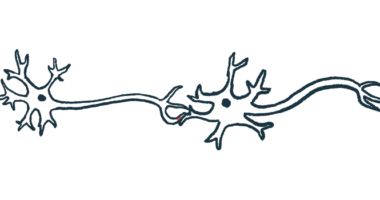Design working on therapy targeting toxic Huntington’s protein
Preclinical studies aim to spot best candidate to bring into clinical testing

Small molecules developed by Design Therapeutics were able to reduce the activity of the disease-causing mutant gene in preclinical models of Huntington’s disease, according to an announcement from the company.
“We are highlighting an exciting new program for Huntington’s Disease, an indication of tremendous unmet medical need,” Pratik Shah, PhD, Design’s chairperson and CEO, said in a company press release.
Design is using its GeneTAC platform to develop potential treatments for a range of diseases caused by nucleotide repeat expansion mutations, where a specific sequence of nucleotides, DNA’s building blocks, are repeated excessively.
Mutations in the HTT gene lead to a toxic protein and Huntington’s disease
This expansion can lead to production of a toxic version of the resulting protein — as is the case of Huntington’s — or reduced levels of a given protein, as in Friedreich’s ataxia, another neurodegenerative disease.
Excessive nucleotide repeats also can result in the generation of abnormal molecular structures, as in Fuchs endothelial corneal dystrophy, an eye condition, and myotonic dystrophy 1, a muscular disease.
The GeneTAC platform enables the design of small molecules that regulate the activity of specific genes affected by repeat expansions — either increasing or reducing their activity to counteract the harmful effects of these mutations.
“Our vision is to develop a portfolio of first or best-in-class small molecules capable of treating a host of degenerative diseases by working with a patient’s natural genome to restore cellular health,” Shah said.
Design’s most advanced program, in Friedreich’s ataxia, is testing a potential treatment in clinical trials, and has shown that its GeneTAC approach can effectively regulate target gene activity in patients.
Huntington’s is caused by excessive repeats of three nucleotides — C, A, and G — in the HTT gene, which provides instructions for making the huntingtin protein. The mutated gene copy leads to the production of abnormal huntingtin protein, which is thought to play a central role in driving the disease.
Design’s newly unveiled Huntington’s program aims to develop an optimal small molecule that can reduce activity of the mutated HTT gene copy, thereby lowering levels of the disease-driving mutant protein and other toxic gene products.
According to the company, candidate small molecules have already shown the ability to reduce mutated HTT gene activity in preclinical models when administered systemically, meaning throughout the body, as typically happens when a medication is taken by mouth or injection.
Specifically, systemic administration of candidate molecules led to a greater than 50% reduction in the activity of the mutant HTT gene in the striatum, a part of the brain that is strongly affected by Huntington’s, the company reported.
Design now is working to narrow down its candidates to a single small molecule that shows the greatest promise in preclinical models. Once one is selected, the company hopes to begin working to move it into clinical testing.







